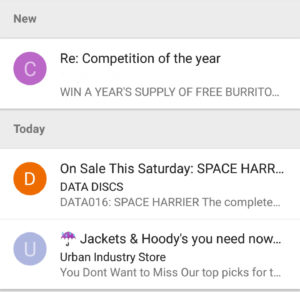15 proven strategies for writing killer email subject lines

With nearly 400 billion emails sent every day, inbox competition is fierce. For some marketers, email subject lines are an afterthought. For others, it comes first. But for most, it’s the single element of any email that they spend the most time agonizing over.
After investing time into crafting compelling copy and designing a beautiful email, none of it matters if your audience doesn’t open it. The subject line is your first impression, and if it doesn’t spark interest, your campaign risks being ignored.
The good news? There are proven best practices that can help you write email subject lines that consistently drive opens. In this guide, we’ll walk through the techniques that make subject lines irresistible and help your emails stand out in even the busiest inboxes.
But first, why email subject lines matter
Your subject line is the first (and sometimes only) chance to capture attention in a cluttered inbox. It’s the gateway to your email message, deciding whether your message gets opened, bypassed, or deleted.
With inboxes overflowing and attention spans shortening, a compelling subject line can be the difference between a successful campaign and a missed opportunity.
Think of it as your email’s title: it needs to be relevant and compelling. Whether you’re driving conversions, clicks, or merely staying top-of-mind, your subject line sets the tone and expectation for what’s inside. Get it right, and you’ve already won half the battle.
Best practices for creating email subject lines
We’ve compiled a list of 15 essential best practices and tips to help you create the best possible email subject lines and ensure that your email campaigns stand out.
1. Know your audience
It feels like it goes without saying, but for any marketing campaign to be successful, you need to know your audience. If you don’t know this, then you don’t know how you should be approaching, addressing, and marketing to your audience. Knowing your audience will help you to devise subject lines that work for you.
2. Personalize but don’t overdo it
If you want to increase your open rate, it’s important to personalize your subject lines. You can grab your reader’s attention by using data fields to pull in information about the customer, like name, location, or other relevant information.
Additionally, targeting your message to the right audience is crucial. Personalization not only makes customers feel valued and understood, but it also provides useful content that can make their lives easier. In an inbox full of generic messaging, personalization can set your email apart.

But personalization works best when it’s thoughtful and sparing. Overusing tactics like first-name insertion can feel generic or even manipulative, especially now that consumers are more aware of marketing strategies.
Helpful tip:
Instead, focus on targeting the right message to the right audience. When personalization feels natural and delivers genuine value, it builds trust and engagement. Keep it fresh by varying your approach and testing what resonates.
Here’s a few examples:
- Personal and value: “Josh, your October campaign results are in”
- Timing and context: “Your customers are holiday-ready — are your automations?”
- Personal: “Thanks for joining us, Josh”
3. Tell your readers what your email is about
Your audience’s time is limited, so clarity is important. Subject lines should clearly communicate the value of opening your email. Be direct; tell readers what they’ll gain, whether it’s access to a new product, an exclusive offer, or helpful content.
Clear subject lines also build trust. When your emails consistently deliver on what the subject line promises, recipients come to expect relevance and honesty from your brand. That trust leads to higher open rates and stronger engagement over time.
For example, if you’re launching a new summer product line, state that clearly. Avoid vague or overly clever phrasing that could confuse or mislead.
The following examples are clear and to the point:
- Our new summer range is here, look and shop now
- Available now: summer styles
- Shop our new summer range today
If anyone opens these emails, they should know exactly what they’re going to see.
4. Don’t mislead the reader
Following on from the previous tip, you don’t want to mislead your readers, as that can be damaging to your relationship.
Don’t promise anything in your subject lines that your email doesn’t deliver on. Not only is this disingenuous, but it’s also spammy. If you take this approach your email campaigns will be winging their way to spam folders in no time at all. Either that or your hard-earned subscribers and customers will be searching for that unsubscribe link.
One misleading tactic that I’m genuinely surprised to be still seeing from brands is the classic ‘RE:’ approach, to make you think it’s a reply to an email that you’ve already sent or received before. It may get you opens, but it also gets deletes, spam reports, and low click-through rates.

5. Be relevant
Relevancy is key. Whether it’s your email copy or your subject lines, shoppers will only answer your emails if it’s going to benefit them.
Don’t be vague or mysterious. Intriguing subject lines might generate good open rates, but your end goal is click-throughs and conversions. And you’re not going to get those if your email isn’t related to your subject line. In the long run, this could actually be detrimental to your brand. By misleading them, you could erode their fragile trust in you.
Helpful tip:
Keep your subject lines related to your key message. It’ll increase the quality of opens and consequently improve your click-through rate.
6. Keep your subject lines short and snappy
Nearly 50% of all emails are now opened on mobile devices. This brings another issue for you to deal with when writing engaging subject lines for your email marketing campaigns. Smaller screens mean less space to work with.
With most mobile email clients, you’ll probably only have around four or five words before your subject line is cut off.
Therefore, it’s important to make your subject line pop in those first four or five words. If you can make a strong subject line in just four or five words (or less) then do it.
7. Vary email subject line length but keep it clear and concise
Many email clients like Gmail and Yahoo cut subject lines when they’re being viewed by web-based readers. Usually, the cut-off point for this is around the 55-character limit. Mobile inboxes, on the other hand, commonly cut off subject lines at about 30 characters.
To ensure that your subject lines are making an impact, be sure to check your campaign reporting. This will help you identify the device on which your customers are opening. Then, you can plan your email subject lines around this suggested length.
Helpful tip:
Now,this doesn’t mean that you must strictly stick to these character limits. One of the best parts of working on subject lines is the ability to experiment. Don’t think about it as trial and error – think of it as trial and trial and trial until success.
8. Avoid spam words
It’s every email marketer’s nightmare to have their hard word flagged as spam. With billions of emails sent and received every day around the world, it’s increasingly difficult to stand out from spam.
After all the work that goes into creating a fully optimized email marketing campaign, you don’t want to be the one in five that gets caught by the spam filter.

Spam filters are constantly checking for specific triggers that indicate an email might be spam, such as:
- Specific word choice
- Messages in ALL CAPS
- Emails without an unsubscribe button
- Links to unknown or questionable websites
- Colorful, hard to read, and different sized fonts
- Stay away from heavy use of exclamation marks!!!!!!!!
- Avoid overzealous use of currency signs ($$$$$ or £££££, for example)
Typically spam filters look for suspicious words or phrases associated with scams, schemes, free gifts, and more.
So, with that in mind, here’s what to avoid:
- Spam words that make exaggerated claims and promises, e.g. #1, 100% satisfied, earn money, free consultation, and satisfaction guaranteed.
- Words that create unnecessary urgency and pressure, e.g. act now, apply now, get started now, please read, while supplies last, and more.
- Spammy words or words that imply shady or unethical behavior, e.g. cancel at any time, no hidden charges, meet singles, etc.
- Words that are considered jargon or typically used in legal documents, e.g. as seen on, bonus, certified, cheap, join millions, this message contains, a quote, and more.
Of course, this doesn’t mean you can’t EVER use these words in your emails. It just means to use these words and phrases responsibly.
Helpful tip: what are the best performing email subject lines?
The best performing email subject lines have included words like ‘reasons’, ‘introducing’, ‘discover’, and ‘recent’. This indicates that customers are looking for content that inspires, such as ‘introducing our new range. They want brands to do more than simply push a product, they want you to sell it.
9. Emojis have their place but use them wisely
Emojis have found their way into almost every aspect of everyday life. Heck, they even made a truly awful movie about them. So, don’t be afraid to give them a whirl in your email marketing campaigns.
Back in the day, early emoji adopters certainly stood out in their recipients’ inboxes. But slowly marketers have come to realize that these cheeky little icons can help you catch the reader’s eye.

So, when used effectively, emojis can help your subject lines stand out. Econsultancy summed up its recent research into emoji usage in subject lines, noting that an emoji ‘makes a good subject line better’, or ‘makes a bad subject line worse’.
So again, you need to ensure that you’re using emojis in the right way for them to be effective.
It’s important to consider some pros and cons when using emojis in subject lines.
Some of the pros include:
- They can help your email subject lines stand out.
- They’re more emotive.
- You can use them to get a point across without the need for words.
- Especially useful for mobile.
- When used properly, they can add context to your email subject lines (again, useful for mobile).
And some of the cons include:
- Improper use can be detrimental.
- Inconsistent rendering across mobile devices, platforms, and email clients (a good resource to check the differences is Emojipedia – The ‘grimacing face’ emoji is a great example of how emojis can look very different cross-platform).
- Some audiences won’t like them (which takes us back to the first tip – know your audience).
- Irrelevant use can be confusing – is it immediately obvious what the emoji is, and why it’s being used? If the answer to either is no, don’t use it.
- Some emojis can have multiple meanings, so make sure you understand any and all meanings before you use them.
10. Tell, don’t sell
Steer clear adding unnecessary descriptive adjectives to your subject lines. Words like ‘amazing’, ‘unbeatable’, and ‘stunning’ actually do very little to convince recipients to open.
Our Global benchmark report revealed that false urgency in subject lines doesn’t perform well. Words that were once considered to inspire action are driving inaction. Especially in retail sectors where the worst performing subject lines included words like:
- ‘exclusive’
- ‘days’
- ‘ends’
- ‘save’
- ‘extra’
- ‘last’
Keep it simple and tell readers what they can expect from your email. There’s no need to make grand promises and oversell what is simply a new product launch, event, or mid-season sale.
Once again, this will improve the quality of your opens. When it’s clear to the reader what’s inside you’re giving them more reason to convert.
11. Show some brand personality
Most of the subject lines that lead me to open emails in my inbox are either to the point or have a bit of personality shining through. Adding personality to your subject lines can be a powerful tool in getting recipients to open.
This tip relies heavily on your brand’s tone of voice:
- Are you a playful brand?
- Can you be cheeky?
- Are you a leading authority in your field?
Your tone of voice is your brand personality, so you must have a clear understanding of it before you start writing your subject lines.
Even better, if your tone of voice allows you to have some fun with your subject lines, then do it. As long as you keep it relevant, it opens up a world of limitless possibilities for your subject lines.
12. Ask questions
One of the best ways to get a customer to complete an action is to pique their interest and curiosity. Asking a question in your email subject line is the perfect way to do this.
For example, if you’re a retailer, it can be as simple as asking whether the recipient wants to see your new collection, or even better, receive a discount on their next order. Or if you’re a B2B business, you can ask a question that is relevant to some content that you’ve produced, as we did with our global benchmark report:
Hi Katie, do you want 20% off your next order?
How do your results compare to the competition?
The reader’s natural curiosity is enough to make them want to click. When they do, it’s up to you to make sure you keep them curious enough to click through the email.
13. Include a call to action (CTA)
You want customers to complete an action. That’s why you’re emailing, so why not be clear about what you want? Positive action verbs are a good option as long as you’re careful not to come across as spammy. Think along the lines of:
- “get yours”
- “discover”
- “save”
- “join us”
- “book today”

If you’re worried about coming across as a spam sender (we’ll be covering how best to avoid this later) then try making key benefits or propositions the CTA in your email subject line. If the key benefit of shopping with you comes from your offer of free shipping, push this in your subject line. If you’re offering student discounts, shout about it to drive opens.
Helpful tip:
Essentially, you should be thinking, “What will drive my readers to convert?” Whatever the answer, try running with it in your email subject line.
14. Overcome writer’s block with artificial intelligence (AI)
To ensure your email subject line is clear, relevant, and engaging enough to convert, you should be writing it last.
After you’ve finalized your email design and written your copy, you’ll know the exact message you’re trying to communicate. With that in mind, deciding what to include in your email subject line will be much easier.
Have a look at our AI playbook to explore the best practices of editing and proofing AI copy.
15. A/B test your subject lines
Perhaps the most important tip of all is to make sure that you’re always testing your subject lines and measuring their performance and impact.

What worked well for one segment may not work for another, and what worked yesterday may not work today. By A/B split-testing your email campaigns, you can identify what works best and tweak your subject lines accordingly to get the best possible performance from your campaigns.
Tips on testing your subject lines
Here’s what to consider when testing your subject lines:
Don’t get caught up in what you think your recipients expect
While, to a certain extent, you do have to predict what your recipients want, that doesn’t mean you know what they’re expecting. Keep them on their toes with your campaigns, and they’ll become more inclined to open your emails.
Don’t be cautious
Playing it safe is fine if you want to do okay. But most of us want to do better than okay. So that means throwing caution to the wind with your subject lines and stepping out of your comfort zone. It’s okay to brainstorm some really ridiculous subject lines, before scaling them back to something that you are happy with.
Monitor what works and what doesn’t
Make sure you’re tracking any tests that you’re doing so that it’s easy to look back and see which type of subject lines worked best. Otherwise, you’ll end up not knowing which types of subject lines work best for certain types of campaigns.
Don’t stick with a subject line that worked once, or worked well two years ago
While it may be easy to stick to the old adage of ‘if it ain’t broke, don’t fix it’, this doesn’t really work with email subject lines. While you may want to stick to a certain formula if you’re sending regular, consistent email campaigns, you should also consider that recipients will get used to seeing the same types of subject lines. In time, they could become blind or oblivious to them.
One approach you can use is to ensure that the first part of your subject line identifies the type of email you’re sending, before specifying the content it contains.
Let’s take an email example
Let’s say you send a monthly newsletter to your subscribers, but all you do is change the month. So, your subject line looks like this:
May Newsletter
It’s not the most inspiring or eye-catching subject line that you can use here, is it? This is where emojis can be useful. You can add context to them, and over time your recipients will begin to associate that emoji with a certain campaign. Seeing as we’re talking about a newsletter campaign, let’s use the newspaper emoji.
Then you also add a callout to some specific content that’s included in your newsletter. This will make the subject line different every time, while still being clear about its contents. Put these elements together, and you end up with a subject line that looks like this:
📰May Newsletter: email tips, cookie update, and features
Sure, it’s a lot longer, and the full subject line will likely be truncated on some displays, but it’s better. By using an emoji and adding clear information about what the email contains, it’s already more appealing to the recipient.
Key metrics to track and measure success
While a high open rate might feel like a win, understanding how well your subject lines are really performing means looking at a few key numbers. These metrics offer deeper insights into whether your compelling headlines are actually leading to engagement and results.

Here’s what you should be tracking:
- Open rate: This is the percentage of people who opened your email out of everyone it was sent to. It’s the first indicator of how well your subject line grabbed attention.
- Click-through rate(CTR): This shows the percentage of recipients who clicked on a link within your email after it was delivered. It tells you if your subject line led to further engagement with your content.
- Click-to-open rate(CTOR): This metric looks at the percentage of people who clicked a link out of those who actually opened your email. It helps you understand how relevant your content was to those your subject line attracted.
- Conversion rate: This tracks the percentage of recipients who completed a desired action (like a purchase or sign-up) after clicking through from your email. It’s a key indicator of whether your subject lines are driving business goals.
- Unsubscribe rate: This is the percentage of recipients who opted out of your email list after receiving a particular campaign. A sudden spike could indicate issues with your subject line or content.
- Spam complaint rate: This critical metric shows the percentage of recipients who marked your email as spam. High rates can damage your sender reputation.
Now you know how to write email subject lines
By experimenting with these subject line tips and analyzing your audience’s response, you can identify what resonates best with them. Remember to keep it concise, intriguing, and relevant to the content of your email.
Dive into our guide, “Don’t be a copywronger”, and uncover expert tips for creating irresistible subject lines and competitive campaign copywriting.



